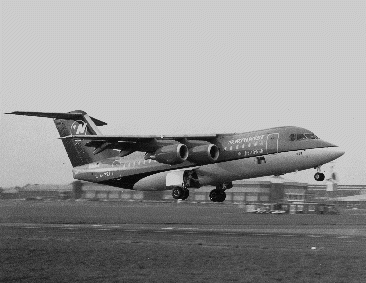
Kevin O'Toole/MANCHESTER
British Aerospace Regional Aircraft is studying further developments for its Avro RJ family, including new avionics and engine options, with the intention of improving the aircraft's economics and keeping the programme up to date.
Although the RJ is now effectively alone in the 85- to 100-seat regional jet market, its future has been clouded by the uncertainties surrounding the Aero International (Regional) venture with ATR on sales and support.
Mike O'Callaghan, new managing director at the regional aircraft plant in Woodford, Manchester, however, stresses that BAe plans to continue investing in the RJ. Speaking at the handover ceremony for the 100th RJ, delivered to Northwest Airlines for its Mesaba affiliate, he points out that the group has underlined its support for the programme by including RJ development in its latest ten-year corporate plan. The BAe board has already pledged to use future profits from the programme, which returned to breakeven in 1997, to re-invest in the product.
Options being considered include the new AS108 engine being offered by AlliedSignal in place of the existing LF507. AlliedSignal has outlined plans to put the new engine, which will be developed from the LF507, into service by the end of 1999, but has yet to find an application.
Another study is looking at the possibility of equipping the RJ cockpit with cheaper, general aviation avionics, like those used on the smaller Embraer RJ-145 and Bombardier Canadair Regional Jet. The Avro RJ now has an avionics suite to full Arinc standards. No decision has yet been made, says O'Callaghan.
Since its launch five years ago as an upgrade to the BAe 146, BAe has already made performance improvments in the RJ, raising the maximum cruise altitude from 31,000ft (9,500m) to 34,000ft and upgrading landing systems to achieve close to a Cat 3b very-low- visibility capability.
Other investigations are looking at ways to take further cost out of the aircraft. O'Callaghan believes that there is still room for further production efficiencies, although not on the scale of the original sweeping changes. Since 1991 the manufacturer has cut assembly time from 29 to 11 weeks and cut component costs by 40%.
O'Callaghan hopes that BAe's partnership talks with Malaysia, which could include the sale of a stake in Avro, will also lead to a source of new low cost supply. Malaysian ambitions include developing competences in metal and composite fabrication as well as systems development and maintenance. The talks continue and could be slowed by the economic crisis in Asia-Pacific. BAe is optimistic of something emerging this year, however.
Source: Flight International























